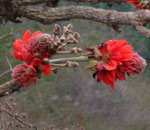Erythrina latissima
Broad-leaved Coral Tree
; Breeblaarkoraalboom
(Afrik); umGcwabagcwaba, siPhama (Siswati); Mphapha (North Sotho);
Muvhale (Venda); umNqwane( Xhosa); umGqwabagqwaba, umQongqazi (Zulu)
Article by Geoff Nichols
This deciduous
rounded crowned tree of the rocky north
west facing hillsides of the eastern Cape, KwaZulu-Natal, Mpumalanga,
Limpopo provinces, Swaziland, and Zimbabwe is a feature of the
grasslands that just edge onto the escarpments that drop down into the
Lowveld areas of Southern Africa.
The large
broad rough textured tri-foliate leaves make a very bold
statement in the veld but in a garden this is even more noticeable due
to the fact
that the tree when planted up close to you in a smaller scale area than
the
open expanses of Africa seems just that much larger. This species tends
to
flower a little later than its cousins and I have seen flowers in July
here
on the coast but as you move inland the flowers will still be on the
tree
in late August or September.
The
flowers are bright red and it is at this time against the brown
colour of the veld grasses that this tree comes into its own.
|

Click here
|
The
flowers are also more robust and chunky in size and texture. Even as a
young tree the trunk is corky and thick allowing this species to
survive the winter fires that sweep across the grassland slopes where
it makes it home.
As a garden plant you need to get a young seedling and place it in a
sunny well drained spot where it can be allowed to grow to its full
size without being cramped by other trees or buildings. This tree will
grow from truncheons but I really would not urge gardeners to go out
and remove large branches off wild trees simply because if this pruning
is not done with a bit of thought you can spoil the shape of a wild
tree. But this is my personal opinion and I am sure people removing
truncheons will take the shape of the original tree
into consideration.
Seed is produced in large round segmented pods that again stand out
when they are ripe. The seeds are bright red and about 10mm in size
roughly oval in shape. The seed will germinate easily in about 10 days
if sown in a tray of normal seedling mix that is kept in a warm sunny
spot. I always nick the hard seed coat to speed up the germination
process. However if you live in a frost area the seedlings need to be
kept sheltered for the first year and then the plant is able to
withstand frost like its parent after that.
Remember this is not an instant tree it takes at least 20 years for a
seedling to begin looking like a tree and it will also take that time
for the tree to produce its first flowers. This is one of the reasons
that gardeners prefer to take truncheons for their gardens so that they
can see flowers in a shorter time. Sunbirds, Vervet Monkeys if this
tree is growing within striking distance of a forest or valley bushveld
and many insects visit the flowers to sip the
nectar and feed on the pollen.
